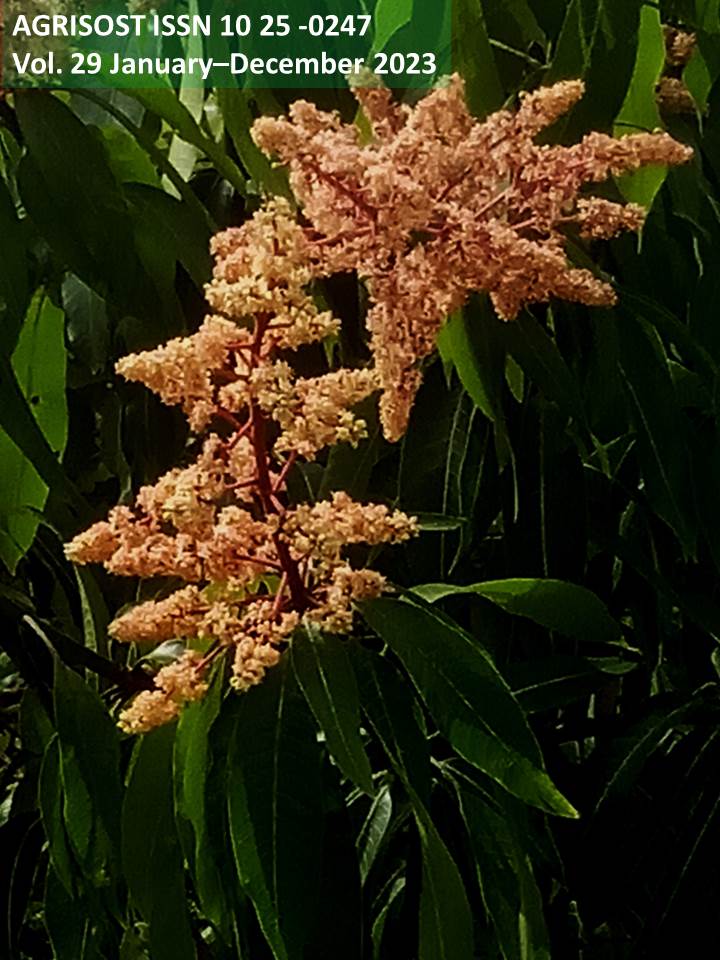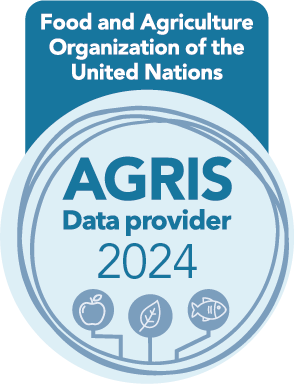Comparación de los rendimientos del maíz, empleo de agua y crecimiento bajo diferentes sistemas de laboreo y tipos de fertilizantes
DOI:
https://doi.org/10.5281/zenodo.8319717Keywords:
laboreo mínimo, agricultura de conservación, empleo eficiente del agua, crecimiento del maízAbstract
Contexto: EL maíz es uno de los cuatro cereales más importantes después del trigo y el arroz. El nitrógeno y variadas formas de laboreo son factores importantes para mejorar los rasgos y el rendimiento del maíz. La agricultura sostenible requiere de mejoras en cuanto al manejo del laboreo de los suelos, así como una aplicación más eficiente de los fertilizantes como recursos agrícolas.
Objetivo: Esta investigación se enfocó en la importancia de realizar exámenes a las condiciones de los nutrientes, particularmente el consumo de nitrógeno en varios sistemas de laboreo, así como el impacto de estos factores en el rendimiento, crecimiento y eficiencia en el empleo del agua en el maíz cultivado en Irán.
Métodos: El experimento se desarrolló en una parcela dividida, mediante un diseño experimental completamente aleatorio por bloques y cuatro réplicas, en la ciudad de Darreh shahr, provincia de Ilam, Irán. Los tratamientos consistieron en tres niveles de laboreo del suelo, incluyendo la siembra directa, mediante el laboreo combinado y surcos (arado Moldboard + gradas dobles + nivelador y surcos en la parcela principal).
Resultados: Se demostró que la mayor cantidad de materia seca total se obtuvo en el tratamiento con mínimo laboreo (4542,7 g/m2), mientras que el menor valor se obtuvo mediante el cultivo tradicional (4029,2 g/m2). El volumen de fertilizante no utilizado (NPK)0 fue de 0,61 kg-m3. Se puede afirmar que el laboreo mínimo puede mejorar los rendimientos del maíz con el más alto EEA, y también puede incrementar sus propiedades durante la temporada de crecimiento.
Conclusiones: Según los resultados de este estudio, se puede afirmar que el laboreo mínimo mejora los rendimientos del maíz con el más alto EEA, y también puede incrementar sus propiedades durante la temporada de crecimiento.
Downloads
References
Adiku, S.G., Ozier-Lafontaine, H., & Bajazet, T. (2001). Patterns of root growth and water uptake of a maize-cowpea mixture grown under greenhouse conditions. Plant and Soil, 235(1), 85-94. https://doi.org/10.1023/A:1011847214706
Albayrak, S., & Camas, N. (2005). Effects of different levels and application times of humic acid on root and leaf yield and yield components of forage turnip (Brassica rapa L.). Journal of Agronomy. 4(2), 130–133. https://doi.org/10.3923/ja.2005.130.133
Ball, B. C., Scott, A., & Parker, J. P. (1999). Field N2O, CO2 and CH4 fluxes in relation to tillage, compaction and soil quality in Scotland. Soil and Tillage Research, 53(1), 29-39. https://doi.org/10.1016/S0167-1987(99)00074-4
English, M., & Raja, S. N. (1996). Perspectives on deficit irrigation. Agricultural Water Management, 32(1), 1-14. https://doi.org/10.1016/s0378-3774(96)01255-3
Eshel, G., Egozi, R., Goldwasser, Y., Kashti, Y., Fine, P., Hayut, E., Kazukro, H., Rubin, B., Dar, Z., Keisar, O., & DiSegni, D. M. (2015). Benefits of growing potatoes under cover crops in a Mediterranean climate. Agriculture, Ecosystems & Environment, 211, 1-9. https://doi.org/10.1016/j.agee.2015.05.002
Farahani, H. J., Peterson, G. A., & Westfall, D. G. (1998). Dryland cropping intensification: A fundamental solution to efficient use of precipitation. Advances in agronomy, 64, 197-223. https://doi.org/10.1016/s0065-2113(08)60505-2
Fathi, A., Farnia, A., & Maleki, A. (2016). Effects of biological nitrogen and phosphorus fertilizers on vegetative characteristics, dry matter and yield of corn. Applied Field Crops Research, 29(1), 1-7. https://doi.org/10.22092/aj.2016.109214
Fathi, A., & Zeidali, E. (2021). Conservation tillage and nitrogen fertilizer: a review of corn growth and yield and weed management. Central Asian Journal of Plant Science Innovation, 1(3),121-142. https://doi.org/10.22034/CAJPSI.2021.03.01
Fey, Y., Jiulin, S., Hongliang, F., Zuofang, Y., Jiahua, Z., Yunqiang, Z., Kaishan, S., Zongming W., & Maogui, H. (2012). Comparison of different methods for corn LAI estimation over northeastern China. International Journal of Applied Earth Observation and Geoinformation, 18, 462-471. https://doi.org/10.1016/j.jag.2011.09.004
Fortin, J. G., Anctil, F., & Parent, L. E. (2013). Comparison of physically based and empirical models to estimate corn (Zea mays L) LAI from multispectral data in eastern Canada. Canadian Journal of Remote Sensing, 39(1), 89-99. https://doi.org/10.5589/m13-010
Habtegebrial, K., Singh, B. R., & Haile, M. (2007). Impact of tillage and nitrogen fertilization on yield, nitrogen use efficiency of tef (Eragrostis tef (Zucc.) Trotter) and soil properties. Soil and Tillage Research, 94(1), 55-63. https://doi.org/10.1016/j.still.2006.07.002
Halvorson, A. D., Mosier, A. R., Reule, C. A., & Bausch, W. C. (2006). Nitrogen and tillage effects on irrigated continuous corn yields. Agronomy Journal, 98(1), 63-71. https://doi.org/10.2134/agronj2005.0174
Kardoni, F., Bahamin, S., Khalil Tahmasebi, B., Ghavim-Sadati, S. H., and Vahdani, S. E. (2019). Yield comparisons of mung-bean as affected by its different nutritions (Chemical, Biological and Integration) under tillage systems. Journal of Crop Ecophysiology, 13, 49(1), 87-102. https://doi.org/10.30495/jcep.2019.664839
Karimi, M. M., & Siddique, K. H. M. (1991). Crop growth and relative growth rates of old and modern wheat cultivars. Australian Journal of Agricultural Research, 42(1), 13-20. https://doi.org/10.1071/ar9910013
Kim, S. H., Hong, S. Y., Sudduth, K. A., Kim, Y., & Lee, K. (2012). Comparing LAI estimates of corn and soybean from vegetation indices of multi-resolution satellite images. Korean Journal of Remote Sensing, 28(6), 597-609. http://dx.doi.org/10.7780/kjrs.2012.28.6.1
Kwaw-Mensah, D., & Al‐Kaisi, M. (2006). Tillage and nitrogen source and rate effects on corn response in corn–soybean rotation. Agronomy journal, 98(3), 507-513. https://doi.org/10.2134/agronj2005.0177
López-Bellido, R. J., López‐Bellido, L., López‐Bellido, F. J., & Castillo, J. E. (2003). Faba bean (Vicia faba L.) response to tillage and soil residual nitrogen in a continuous rotation with wheat (Triticum aestivum L.) under rainfed Mediterranean conditions. Agronomy Journal, 95(5), 1253-1261. https://doi.org/10.2134/agronj2003.1253
Lucas, E. O. (1986). The effect of density and nitrogen fertilizer on the growth and yield of maize (Zea maysL.) in Nigeria. The Journal of Agricultural Science, 107(3), 573-578. https://doi.org/10.1017/S0021859600069744
Muñoz-Romero, V., Lopez-Bellido, L., & Lopez-Bellido, R. J. (2015). Effect of tillage system on soil temperature in a rainfed Mediterranean Vertisol. International Agrophysics, 29(4), 467-473. https://doi.org/10.1515/intag-2015-0052
Mutegi, J. K., Munkholm, L. J., Petersen, B. M., Hansen, E. M., & Petersen, S. O. (2010). Nitrous oxide emissions and controls as influenced by tillage and crop residue management strategy. Soil Biology and Biochemistry, 42(10), 1701-1711. https://doi.org/10.1016/j.soilbio.2010.06.004
Quincke, J. A., Wortmann, C. S., Mamo, M., Franti, T., Drijber, R. A., & Garcia, J. P. (2007). One‐time tillage of no‐till systems: Soil physical properties, phosphorus runoff, and crop yield. Agronomy Journal, 99(4), 1104-1110. https://doi.org/10.2134/agronj2006.0321
Salvagiotti, F., Cassman, K. G., Specth, J. E., Walter, D. T., Weiss, A.,
& Dobermann, A. (2008). Nitrogen uptake, fixation and response to
fertilizer N in soybeans: A review. Field Crops Research, 108, 1–13.
https://doi.org/10.1016/j.fcr.2008.03.001
Thomas, H., Ougham, H. J., Wagstaff, C., & Stead, A. D. (2003). Defining senescence and death. Journal of experimental botany, 54(385), 1127-1132. https://doi.org/10.1093/jxb/erg133
Unger, P. W. (1994). Ridge tillage for continuous grain sorghum production with limited irrigation. Soil and Tillage Research, 31(1), 11-22. https://doi.org/10.1016/0167-1987(94)90091-4
USDA. (2021). Grain: World markets and trade. Accessed August 1, 2021.
https://apps.fas.usda.gov/psdonline/circulars/grain.pdf
Vanhie, M., Deen, W., Lauzon, J. D., & Hooker, D. C. (2015). Effect
of increasing levels of maize (Zea mays L.) residue on no-till soybean (Glycine Max Merr.) in northern production regions: A review. Soil &
Tillage Research, 150, 201–210. https://doi.org/10.1016/j.still.2015.01.011
Downloads
Published
Issue
Section
License
Copyright (c) 2023 Amin Fathi, Davood Barari Tari, Hormoz Fallah Amoli, Yousef Niknejad

This work is licensed under a Creative Commons Attribution-NonCommercial-NoDerivatives 4.0 International License.
You are free to:
- Share — copy and redistribute the material in any medium or format
- The licensor cannot revoke these freedoms as long as you follow the license terms.
Under the following terms:
- Attribution — You must give appropriate credit , provide a link to the license, and indicate if changes were made . You may do so in any reasonable manner, but not in any way that suggests the licensor endorses you or your use.
- NonCommercial — You may not use the material for commercial purposes .
- NoDerivatives — If you remix, transform, or build upon the material, you may not distribute the modified material.
- No additional restrictions — You may not apply legal terms or technological measures that legally restrict others from doing anything the license permits.







